Calcitonin gene-related peptide immunoreactivity and afferent receptive properties of dorsal root ganglion neurones in guinea-pigs
- PMID: 11986384
- PMCID: PMC2290282
- DOI: 10.1113/jphysiol.2001.013086
Calcitonin gene-related peptide immunoreactivity and afferent receptive properties of dorsal root ganglion neurones in guinea-pigs
Abstract
To establish the afferent receptive properties of lumbosacral dorsal root ganglion (DRG) neurones that express calcitonin gene-related peptide (CGRP), intracellular recordings were made with fluorescent dye-filled electrodes in deeply anaesthetised young guinea-pigs. After determination of neuronal functional properties, dye was injected into the soma. CGRP-like immunoreactivity (CGRP-LI) was examined on histological sections of dye-marked neurones. Fourteen of 34 C-fibre neurones showed CGRP-LI. These included 10/21 C-fibre nociceptive neurones. All C-polymodal nociceptors in glabrous (n = 4) but none in hairy skin (n = 4) were positive. Positive C-fibre high threshold mechanoreceptive (HTM) units had receptive fields in dermal or deeper tissue. Four (n = 6) unresponsive or unidentified C-fibre units were positive. Neither C-fibre cooling sensitive (n = 4) nor C-fibre low threshold mechanoreceptive (LTM) units (n = 3) had CGRP-LI. Six of 23 A-fibre nociceptive cells were positive including one Aalpha/beta unit. Three of these positive cells had epidermal and three had dermal/deep receptive fields. Three of 36 A-fibre LTM units exhibited CGRP-LI; all were Aalpha/beta-fibre G hair units. All glabrous skin and muscle spindle units and in hairy skin slowly adapting and field units, and some G-hair units lacked CGRP-LI. CGRP-LI stained fibres were found in tissues containing receptive fields of positive DRG neurones: glabrous skin, near hair follicles and in skeletal muscle. A few substance P-labelled neurones did not exhibit CGRP-LI and vice versa. Thus CGRP expression was detected in under half the nociceptive neurones, was not limited to nociceptive neurones and apart from receptive properties was also related to location/depth in the tissues of a DRG neurone's peripheral terminals.
Figures

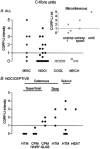

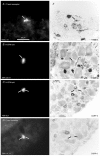
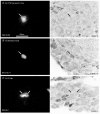
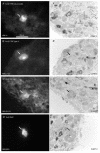
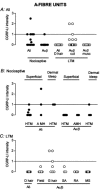
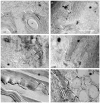
References
-
- Bennett DL, Dmietrieva N, Priestley JV, Clary D, McMahon SB. TrkA, CGRP and IB4 expression in retrogradely labelled cutaneous and visceral primary sensory neurones in the rat. Neuroscience Letters. 1996;206:33–36. - PubMed
-
- Brain SD, Cambridge H, Hughes SR, Wilsoncroft P. Evidence that calcitonin gene-related peptide contributes to inflammation in the skin and joint. Annals of the New York Academy of Sciences. 1992;657:412–419. - PubMed
Publication types
MeSH terms
Substances
Grants and funding
LinkOut - more resources
Full Text Sources
Research Materials

